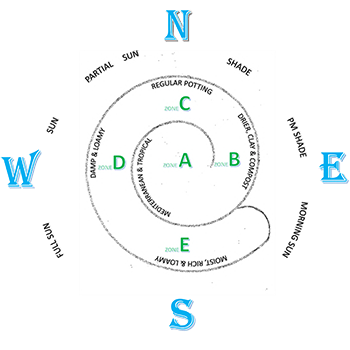Herb Spiral Planting Guide

OVERVIEW
Your new herb spiral allows you to plant herbs according to water, sunlight needs, and growth habits. Place drought-tolerant plants at the top, and water-loving at the base.
By creating these diverse microclimates, you can grow plants that prefer different growing conditions all in one garden space.
Label herbs for future harvesting. Be sure to water well (especially on hot days or if placed where there is lots of direct sunlight); once established water from the top will flow downwards.
Remember the spiral shape creates microclimates you’ll want to take advantage of, so creating a well-thought-out plan of herb placement will produce the best herb garden results.
Below are some general tips for how to plant an herb spiral but the Step-by-Step Guide gives you all the information.
GETTING SET UP
The first stage in making an herb spiral is to decide where it should be located. Herb spirals are usually best situated in full or partial sunshine in a sheltered spot that is protected to some degree from the prevailing winds and searing sun. If you live in an exceptionally hot locale, then partial shade to full shade is best to prevent stress to the herbs.
Now comes the fun part – it’s time to choose your herbs! The Spiral Garden Herb List is a great starting point as it lists herbs by the type of positioning/microclimate they prefer.
Then, make a map of what goes where using our Spiral Garden Planting Worksheet. Our regular-sized spirals typically hold between 9 and 11 herb plants of the size you find at nurseries. Pick a few herbs for each zone then…watch them to grow!
GENERAL
Rosemary, Thyme, Lavender, Marjoram, and other Mediterranean Herbs: These like dry and fairly warm conditions. Set them at or near the top of the herb spiral on the south facing side (north in the southern hemisphere). Rosemary and lavender should be top center of your herb spiral due to their deep roots.
Sage, Oregano: These herbs are amongst those that also thrive in dry conditions but benefit from the shade of plants above them on the herb spiral.
Coriander, Dill, Basil: These plants like more moisture than those above and yet still benefit from being in full sun (at least in cooler climates), so should be placed lower but on the sunnier side of the spiral.
Parsley, Mint, Chives: These plants and others will enjoy shadier and moister conditions on the cooler side of your herb spiral near the bottom.
POSITIONING
! Once your herb spiral is planted it will be heavy and you won’t want to move it much. It is best to determine the location and position before adding dirt and plants!
If using your spiral garden on a deck or patio you will want to place a tray underneath it to catch drips as well as coloration from the weathering metal. If the tray you have doesn’t provide space between the bottom of the planter for water and air to move, place some gravel or other spacer between the base and the tray to provide that flow.
The tallest point on the spiral should face north to provide the most shade to the plants behind it. This also allows the open side of the top to face south, providing plenty of sun for those drier plants.
DIRT
While it is fine to use potting soil throughout, some herbs, such as those towards the top that prefer drier soil, might do well with some sand mixed in. A ratio of no more than 10%-20% sand should do the trick. So, sandy drier soil towards the top, merging into regular soil midway, and then blend in a little compost for loamy soil to create a nice moist environment as you get down to the south/southwest section. Fill unit with dirt to within an inch of the top edge of the spiral wall, it will settle down to about two inches from the top.
DAMS
Dams are the squarish pieces that come with your spiral planter. Use these to help A) separate zones/dirt types, B) slow erosion and water run-down, C) to help level the ground a bit between sections/zones. Placing a dam in the dirt after every 2 or 3 plants allows you to create flatter planting “ledges” which allow for more control over watering and help segregate roots a bit. Just push the dam down into the dirt to where the top edge of the dam is level with the dirt or an inch above it.
TIPS
• Herbs that grow very tall, spread, or expand in width should not be planted in the spiral herb garden because they may suffocate the other plants as they grow.
• Herbs like Mint, Borage, Horseradish, Artemisia, Lovage, Wormwood, and Tansy or those that can become invasive must be planted with care. On our Herb List we identify these with the letter “A” for “Aggressive.” Also, remember that some invasive herbs, like mint, are best planted in a separate pot that fits in the spiral (like the little plastic nursery pots) - be sure there is drainage in the bottom of it.
• Remember that tall plants will create shade for the plants behind them. For some herb combinations this can be good. For instance, planting Cilantro behind Dill seems to work well in hot sun.
• With the herbs, you can also grow salad greens and edible flowers. Or just fill the planter with your favorite flowers and enjoy the color burst!